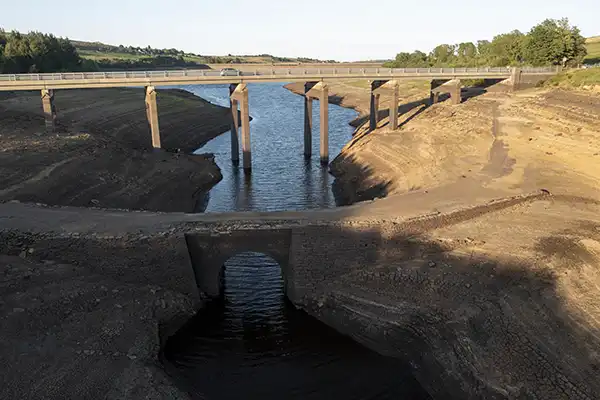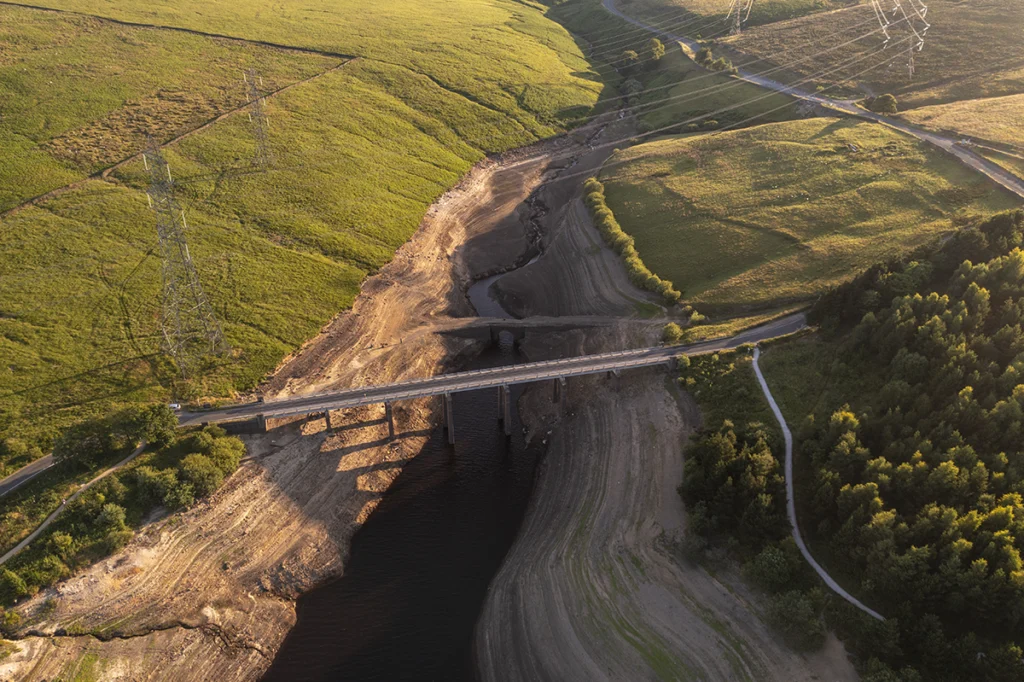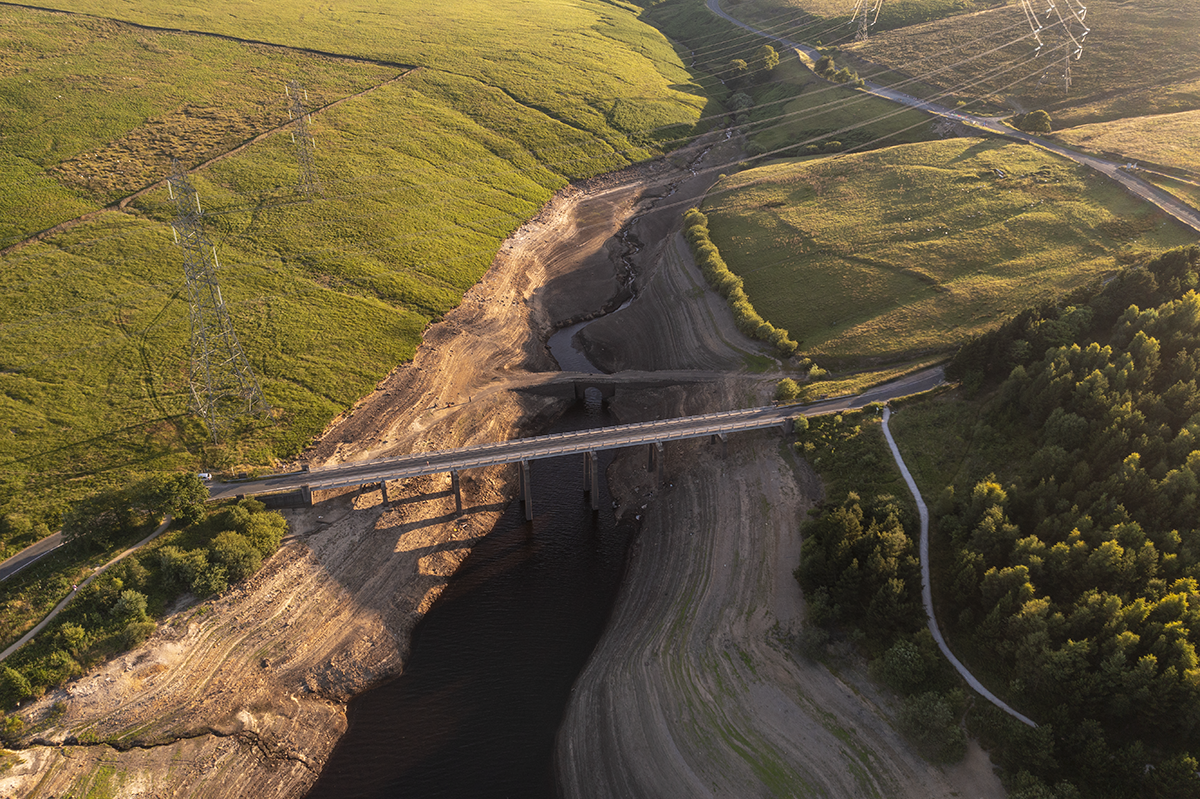Baitings Dam Low Waters – Amazing Drone Footage
Last Saturday evening (12th July), I found myself scrambling up the moorland above Baitings Reservoir with my DJI Mavic 2 Pro and Canon 5D Mark IV in tow, chasing what promised to be some incredible drone footage. The Baitings Dam seriously low waters had done something remarkable to this West Yorkshire reservoir – it had revealed a piece of history that’s usually hidden beneath the water.

This wasn’t my normal landscape photography mission, but my socials have been on fire with all the Baitings Dam seriously low waters across Yorkshire. Everyone’s been sharing images of exposed reservoir beds, dried-up rivers, and revealed structures that haven’t seen daylight for decades. I couldn’t resist joining the conversation with some incredible drone footage.
Ironically, for someone who lugs camera gear up every fell in Yorkshire, I ended up leaving my camera in the bag for the entire evening. Sometimes incredible drone footage captures perspectives that traditional photography simply can’t match, and this was definitely one of those moments.
A Photographer’s Dream Landscape
The packhorse bridge at Baitings Dam, normally submerged under metres of water, was standing proudly in the evening light like something from a different era. The seriously low waters had transformed the entire exposed reservoir bed into something almost alien-like. The cracked, dried mud created patterns and textures that I’d rarely seen since moving to Yorkshire. It was like discovering a forgotten planet right on my doorstep.
These ancient stone structures are scattered across the Yorkshire Dales and Pennines, remnants of when pack trains of horses carried goods across the challenging terrain. To see one so clearly exposed due to the seriously low waters, surrounded by this otherworldly landscape, was perfect for incredible drone footage – even if I ended up capturing it all through the drone’s lens rather than my trusty camera.
The Technical Challenge – And A Few Heart-Stopping Moments
Flying in the Pennines always presents its challenges, but this location had an extra layer of danger that kept me on edge throughout the entire shoot. The reservoir is surrounded by electricity pylons and power cables – the kind of infrastructure that would make any drone flight its absolute last mission if you got too close. I found myself constantly checking the drone’s position, knowing that one miscalculation or gust of wind could send my DJI Mavic 2 Pro straight into high-voltage cables.
The wind can be brutal up here, and I needed to be extra careful with the drone’s stability in the bright evening light. The surrounding hills create unpredictable air currents, so I kept the flight low and steady, using the drone’s obstacle avoidance to navigate safely around the exposed reservoir bed – whilst giving those menacing pylons a very wide berth.
There were moments when I genuinely questioned whether I was pushing my luck too far. The drone’s return-to-home function became my best friend, knowing it would automatically navigate back if I lost signal or the battery ran low. But the incredible drone footage I was capturing was too good to miss – sometimes you have to dance with danger to get the shot that tells the story.
Capturing History in an Alien Landscape
What struck me most was the craftsmanship visible in the bridge’s construction, but equally mesmerising was the surreal surface surrounding it. The dried reservoir bed had cracked into geometric patterns that looked more like something from Mars than the Yorkshire moors. These formations, rarely seen since the reservoir was first filled decades ago, created an almost post-apocalyptic backdrop for the ancient stonework.
Even after decades underwater, the bridge’s stonework remained solid and defined. Through the drone’s camera, you could see the careful placement of each stone, the gentle arch that has withstood centuries of Yorkshire weather, and the way the structure perfectly complements this newly revealed, otherworldly landscape.
My Benro Tortoise tripod stayed folded for the entire evening – this was purely drone territory. The aerial perspective was essential to capture the full scale of this transformed environment, something that ground-based photography simply couldn’t convey.

Behind the Scenes
For those interested in the technical side, this was purely a drone mission. My camera spent all of the evening safely tucked away in my Lowepro Pro Trekker 450 AW II – sometimes the best camera is the one that stays in the bag when the drone can tell the story better.
I was shooting in 4K with the DJI Mavic 2 Pro, constantly monitoring the battery levels and keeping a nervous eye on those power lines. The Hasselblad camera system on the Mavic delivered the image quality I needed, whilst the drone’s intelligent flight modes helped me maintain safe distances from the surrounding infrastructure.
The PolarPro ND filter set for the DJI proved essential for mastering and taming that exposure – especially when shooting video in manual mode. Flying away from the sun and then back into it created some challenging lighting conditions that would have been impossible to manage without proper filtration. The filters allowed me to maintain consistent exposure settings whilst capturing the dramatic contrast between the bright sky and the shadowed areas of the dried reservoir bed.
I was shooting in D-Log to capture the maximum dynamic range from the scene, knowing I’d be learning to colour grade in DaVinci Resolve later. The flat, desaturated footage might not look like much straight out of the camera, but it gives you incredible flexibility in post-production. The 4K footage was absolutely pushing my 7-year-old PC to its limits though – every render was a test of patience and processing power.
One of the most nerve-wracking moments came when I decided to fly the drone through the old bridge itself. Threading the DJI Mavic 2 Pro between those ancient stone arches, with the pylons looming nearby and the wind gusting unpredictably, was genuinely heart-stopping. But the footage of emerging from beneath that centuries-old stonework was worth every anxious moment.
The MindShift Gear Filter Hive kept my PolarPro ND filter set organised and protected during the scramble over the rough terrain – there’s nothing worse than discovering scratched filters when you’re miles from anywhere. The bright evening sky and challenging lighting conditions as I flew from shadow to sunlight demanded careful exposure management to retain detail across the entire scene.
Social Media Coverage
The footage has also been shared across my social media channels, where you can follow more of my outdoor adventures and photography tips:
I’m on Tiktok
What This Means for Yorkshire
Seeing structures like this emerge reminds us of Yorkshire’s rich industrial and transport heritage. These packhorse bridges were the motorways of their time, connecting communities and enabling trade across the challenging Pennine landscape. The fact that this one has survived so well underwater speaks to the skill of its builders and the quality of local stone.
As water levels hopefully return to normal with future rainfall, this bridge will disappear beneath the surface once more. But for now, it stands as a testament to Yorkshire’s enduring landscape and the surprises it still holds for those willing to explore with a camera in hand.
The Equipment That Made It Possible
This shoot perfectly demonstrated why I’ve invested in quality gear over the years. The DJI Mavic 2 Pro delivered the aerial perspective that ground-based photography simply can’t match, whilst my camera waited patiently in the bag – sometimes knowing when not to use equipment is as important as knowing when to use it.
Having the right equipment meant I could manage the bright sky whilst retaining detail in the darker areas of the reservoir bed. It’s these technical details that separate a good shot from a great one, especially when you’re working with once-in-a-lifetime conditions like these.
Looking Forward
With the very dry weather we’ve been experiencing, we might see more of these hidden features revealed in the coming months. It’s a reminder of why I always keep my gear ready and my batteries charged – you never know when history might literally surface in front of you.
The Yorkshire landscape continues to surprise me after years of exploration, and moments like these remind me why I fell in love with outdoor photography in the first place. There’s something magical about combining modern technology with ancient craftsmanship, capturing the past through the lens of the present.
Have you spotted any interesting features revealed by the recent dry weather? I’d love to hear about your discoveries – drop me a message via the contact page. And if you’re interested in more behind-the-scenes content from my outdoor adventures, don’t forget to follow me on TikTok and check out my other gear reviews and location guides.
Further Reading
For more coverage of the Baitings Dam low water levels and revealed packhorse bridge, check out this article from the Halifax Courier: https://www.halifaxcourier.co.uk/news/environment/hosepipe-ban-amazing-photos-show-revealed-packhorse-bridge-at-dried-up-west-yorkshire-reservoir-baitings-dam-5215523

